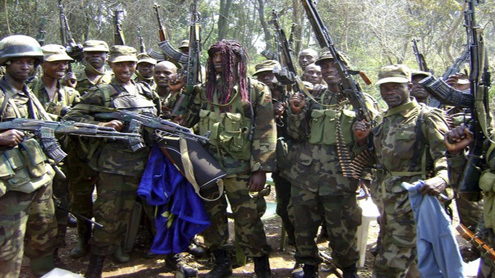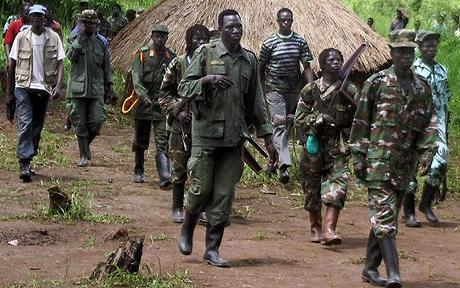
The world has come to know of the over 200 schoolgirls abducted from their dormitories in Government Girls College Chibok, Borno State, Nigeria, on the14th of April 2014. The world is outraged that such a crime against humanity could take place under our watch. With the whole world condemning this dastardly act the days tick by, hopes of finding these innocent girls deems with each passing day.
Is this the first of it's kind? If not what lessons can we draw from past experiences?
This is the story of a similar experience that happened in Uganda, it is a long story and so I will present it in two parts. I hope we learn a thing or two from this to help us prevent future occurrence.
Special thanks to Blog visitor Milar who brought this to my notice.
In October 1996, one hundred and thirty nine girls were abducted from St Mary's College, in northern Uganda. In an act of extraordinary courage, Sister Rachele, the Italian deputy headmistress, followed the abductors. Her journey took her to the Lord's Resistance Army, led by Joseph Kony, where she managed to secure the release of the majority of the girls. What happened to the remaining thirty girls and thousands of other children who have disappeared from their homes and schools in northern Uganda since the arrival of the Lord's Resistance

Aboke abductions were the kidnapping of 139 secondary school female students from St. Mary’s College boarding school by rebels of the Lord’s Resistance Army on October 10, 1996, in Aboke, northern Apac District, Uganda. The deputy head mistress of the college, Sister Rachele Fassera, of Italy, pursued the rebels and negotiated the release of 109 of the girls. The Aboke abductions and Fassera’s dramatic actions drew international attention, unprecedented at that time, to the insurgency in northern Uganda.
Following the rise to power in January 1986 of President Yoweri Museveni after the victory of his rebel National Resistance Army, the north of Uganda was wracked by conflict as first the rebel Uganda People’s Democratic Army and then the chiliastic Holy Spirit Movement struggled against the new rulers. In January 1987, another rebel group, the Lord’s Resistance Army (LRA) was started by the spirit-medium Joseph Kony and it shortly became the sole surviving rebel force.

Despite attempts by the government to destroy or co-opt the LRA, it remained a weak but threatening force in the northern bush. In early 1994, the character of the LRA changed after it began to be supplied by the government of Sudan. The rebels began to target civilians, mutilating those they thought to be government sympathisers and abducting children as child soldiers and sex slaves.
Most LRA activities at this time were concentrated within the three districts comprising Acholiland:Gulu, Pader and Kitgum. However, the violence sometimes reached into Apac District, which borders Gulu and Pader to the south. On 21 March 1989, the LRA had carried out a raid on St. Mary’s College, a Cambodian school for girls mainly between the ages of 13 and 16. The rebels had abducted 10 schoolgirls and 33 seminarians and villagers, as well as killing others whom they had run across. In that incident, Fassera had tried to follow the rebels but had been forced to turn back after a battle erupted between the LRA force and a patrol of the government Uganda People’s Defence Force (UPDF). Nine of the ten girls eventually escaped, while one was killed in a battle several years later. As a result, a UPDF unit was assigned to protect the college.
By 1996, the security situation had again worsened. The soldiers of the UPDF had been replaced by Local Defense Unit militia. Rumors began to circulate through the countryside that the LRA was beginning to look at St. Mary’s College as a likely target again. Nevertheless, in September 1996, the LDU militia stated that they must move from the college 16 kilometers away to the town of Ikeme. Sister Alba, the mother superior, sent Sister Rachele to negotiate with the LDU commanding officer, who agreed to set up a night patrol if a pickup ferried the soldiers to the college at night and back to Ikeme at dawn.

The LRA almost always attacked at night so this was a key breakthrough. Nineteen soldiers were assigned to the protection of the college, but Alba, feeling that the military presence is insufficient to stop an attack, sent Fassera by bike to ask for 50 soldiers, stating that she would otherwise close the school. Fassera did not have a way to transport the soldiers she was requesting, and the LDU officer calmed her by saying that he would send word if there was any danger.
By 8:15 pm on 9 October 1996, Ugandan Independence Day, the expected soldiers had not yet arrived at the school. The three Sisters held a meeting to decide on a plan of action. The option of moving the girls out of the school and dispersing them was discussed, but it was already dark and the possibility that LRA rebels would be waiting outside to attack, deterred the sisters from this course. An hour later the girls went to bed, though the mother superior stayed up until 11:30pm to pray in the chapel. At 2:30 am, the night watchman at the college knocked on Sister Fassera’s door stating: “Sister, the rebels are here.”
Sister Fassera immediately woke Sister Alba and then moved out of the convent towards the front gate (Which was actually a net) of the compound and spotted the rebels outside the gate. Thinking that the rebels had been slowed by the gate and that they may be able to evacuate the girls through the back gate, the Nuns moved back towards the four dormitories, each of which had about 50 students. However, as they drew closer they saw flashlights around the dormitories and realized that the LRA had already come through the back gate.
In the knowledge that, if caught, the rebels would force them to open the doors, Sisters Alba and Fassera woke the one older nun, Sister Matilde, and together hid in the compound’s stock house. Through the night, they heard the sounds of rebels moving through the compound but never the voice of one of the girls, giving them hope that the rebels had been kept out of the dorms by the iron reinforced doors and windows. Later estimates put the number of armed rebels at about 200. They burned the school vehicle, ransacked the clinic and unsuccessfully attempted to burn several buildings.
As dawn approached, the nuns heard the sounds of the rebels leaving. At first light (approximately 6:30 am) Sister Alba sighted a small group of girls wandering in the open. When asked if they were okay, Claudia, a girl in the second class (the equivalent of eighth grade in the United States or Canada – students are typically age 13-14), stated that the other girls had been taken away. The sisters rushed to the dormitories for classes four, five and six. However the girls inside, believing that the rebels had captured the nuns refused to open the doors. Eventually the students were persuaded out. They reported to the sisters that the rebels had abducted classes one, two and three. One dormitory window had been broken and another’s wall demolished. 152 secondary school girls between 13 and 16 years of age had been taken. At the time none of the sisters were able to perform an accurate count.
To be continued....
Source modalan

No comments:
Post a Comment